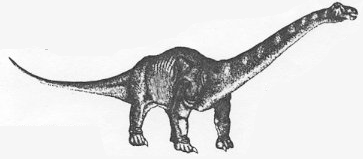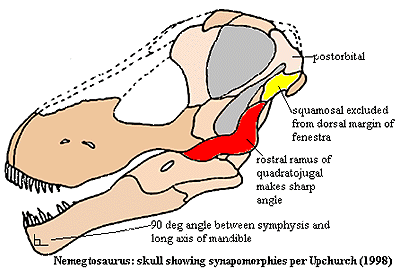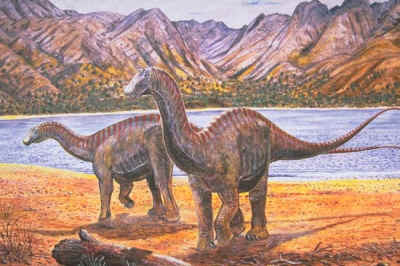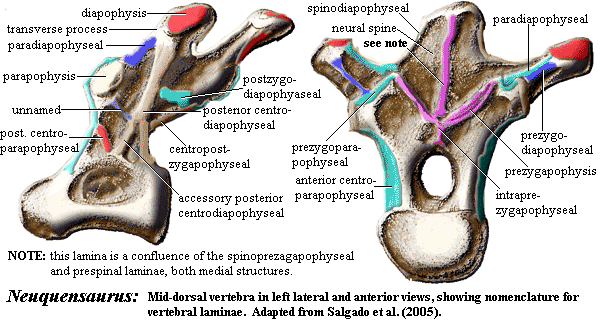 Ampelosaurus: A. atacis Le Loeuf 1995.
Ampelosaurus: A. atacis Le Loeuf 1995.| Sauropodomorpha | ||
| The Vertebrates | Titanosauridae |
| Vertebrates Home | Vertebrate | Vertebrate |
|
Abbreviated Dendrogram
Dinosauria
│
└─Sauropodomorpha
├─Prosauropoda
└─Sauropoda
├─Cetiosauridae
└─Neosauropoda
├─Diplodocomorpha
│ ├─Rebbachisauridae
│ └─Diplodocidae
└─Macronaria
├─Brachiosauridae
└─Somphospondylii
├─Euhelopodidae
└─Titanosauria
├─Nemegtosauridae
└─Titanosauridae
├─Ampelosaurus
├─Epachtosaurus
├─Janenschia
├─Magyarosaurus
├─Nemegtosauridae
│ ├─Quaesitosaurus
│ └─┬─Rapetosaurus
│ └─Nemegtosaurus
└─Saltasaurinae
├─Alamosaurus
├─┬─Titanosaurus
│ └─Jainosaurus
└─┬─Neuquensaurus
└─Saltasaurus
|
Contents
Index |
Titanosauridae: Since Titanosaurus is a somewhat vague genus, and is currently in disfavor as an anchor taxon, "Titanosauridae" is not much used in the literature. While no one is looking, we have absconded with this label and used for an equally vague group consisting of all "traditional" titanosaurians more derived than the most basal genera.
Range: Late Jurassic to Late Cretaceous
Phylogeny: Titanosauria: Andesaurus + Argentinasaurus + * : Ampelosaurus + Epachtosaurus + Janenschia + Magyarosaurus + Nemegtosauridae + Saltasaurinae.
Introduction: This is one of the largest families of dinosaurs. Because Titanosaurus is based on poor materials, it has been suggested that the name be changed to Saltasauridae. Titanosaurids are mostly known from the Cretaceous of Gondwana, especially South America, but they were also representative of India, Madagascar, and even Europe. While some were as huge in size as their name indicates, many were of moderate proportions, and there were also dwarf forms that seem to have been island-dwellers. Many titanosaurids are rather poorly known, and it is not unlikely that - as is usually the case - a lot of the taxa based on fragmentary material will turn out to be invalid. It used to be thought that the Titanosauridae were cousins to the diplodocids. More recent studies reveal that titanosaurid skulls were not diplodocid-like (as restored by von Huene, an early but influential worker in this field) nor extremely flat (as has also been suggested), but were instead similiar to Camarasaurus and Brachiosaurus, although not as high (see illustration of Rapetosaurus). The way in which the teeth mesh together is different from that of other sauropod groups, especially diplodocoids. The head is surprisingly small, even by sauropod standards (say around 30 cm for a 14.5 meter long animal).
A vast nesting colony of titanosaurids has been discovered in Argentina recently, with some fossilised embryos showing skin impressions, and another such possible colony was uncovered in Spain. The embryo skin impressions indicate (according to the placement of these scales) that these titanosaurs would not have sported the keratinous dorsal spikes found associated with a diplodocid specimen. See Czerkas 1997). Neither were the juveniles feathered.
The existence of nesting grounds indicates that these were social animals, perhaps congregating and nesting in large heards. Possibly the safety of numbers protected them from the carnivorous abelisaurs that were well placed to be their main predator. (MAK 011115)
 Ampelosaurus: A. atacis Le Loeuf 1995.
Ampelosaurus: A. atacis Le Loeuf 1995.
Range: Late Cretaceous Maastrichtian) of Europe (France)
Phylogeny: Titanosauridae: Epachtosaurus + Janenschia + Magyarosaurus + Nemegtosauridae + Saltasaurinae + *.
Characters: teeth slightly spatulate; neural arches bent posteriorly; armored, with several diffrent types of armor (plates, spines, etc.).
Ampelosaurus atacis Le Loeuff, 1995
Horizon: Aude Valley, Esperaza, France
Age: early Maastrichtian
Place: European islands (France) (Central Laurasia)
Remains: several individuals; most of a skeleton, at least 20 different specimens in all
Length: 15 meters
Comments: A primitive titanosaurid known from good material. A number of types of armor have been found with it, indicating that primitive as well as advanced titanosaurs possessed bony plates in the skin.
Links: Dinosaur hunting in the South of France; DinoData Dinosaurs A100 AMPELOSAURUS; DinoMania! - Le dinosaure Ampelosaurus (French); Ampelosaurus atacis; MUSEE.DINOSAURES - AMPELOSAURUS; AMPELOSAURUS; Ampelosaurus atacis; Paleontology and Geology Glossary; GLOSSAIRE. MAK 011115, ATW020818.
Range: Late Cretaceous of South America
Phylogeny: Titanosauridae:Ampelosaurus + Janenschia + Magyarosaurus + Nemegtosauridae + Saltasaurinae + *.
Epachtosaurus sciuttoi Powell, 1990
Age: Campanian-Maastrichtian
Place: west Gondwana Argentina)
Remains: postcrania
Length: 15-20 meters
Comments: a primitive late surviving form, this species seems to lack the typical titanosaur osteoderms. Originally thought to be Cenomanian mid Cretaceous, it appears to be later Cretaceous instead, making it a sort of "living fossil" existing alongside more advanced saltosaurid titanosaurs. (MAK 011115).
Range: Late Jurassic of Africa
Phylogeny: Titanosauridae:Ampelosaurus + Epachtosaurus + Magyarosaurus + Nemegtosauridae + Saltasaurinae + *.
Janenschia robusta (Fraas, 1908)
Horizon: Upper "Saurian beds" Tendaguru, Tanzania
Age: Late Kimmeridgian
Place: central Gondwana
Remains: limb and vertebaral elements
Length: 24 meters
Weight: 30 tonnes
Comments: this wastebasket taxon is composed of all sauropods that couldn't be placed in the other Tendaguru sauropod taxa (including some genuine Titanosaurids that are the earliest representatives of the group). Also previously known as Gigantosaurus. (MAK 011115).
Magyarosaurus: von Huene 1932. M. dacus Nopcsa 1915, M. transylvanicus von Huene 1932 (probably a synonym).
Range: Late Cretaceous Maastrichtian) of Eastern Europe
Phylogeny: Titanosauridae:Ampelosaurus + Epachtosaurus + Janenschia + Nemegtosauridae + Saltasaurinae + *.
Magyarosaurus dacus Huene, 1932
Synonym: Titanosaurus dacus Nopcsa, 1915
Horizon: Sinpetru Beds, Hunedoara, Romania
Age: late Maastrichtian
Place: European islands (Romania) (Central Laurasia)
Remains: isolated postcranial material of at least 10 individuals
Length: 5.25 meters
Weight: 600 kg
Comments: the smallest known adult sauropod, this little animal would seem to have been an island dweller. Often limitations of food, and absence of large predators, on islands result in previously large animals evolving into smaller forms (like the dwarf elephant Elephas falconeri) of Pleistocene Malta). As the remains include both robust and slender humeri, it is likely that these are from several different species of dwarf sauropods. (MAK 011115).
Note: Recent evidence indicates that Magyarosaurus may have been another armored titanosaur.
Links: DinoData Dinosaurs M012 MAGYAROSAURUS; MAGYAROSAURUS; Paleontology and Geology Glossary- Ma; New evidence of armoured titanosaurids; Dinopedia ATW030427.
 Nemegtosauridae: Antarctosaurus, Malawisaurus, Nemegtosaurus, Phuwiangosaurus, Quaesitosaurus, Rapetosaurus. This group is used without a name by [R&F]. Since it incorporates all the members of the Nemegtosauridae Barrett & Upchurch 1995), I use that name as a matter of convenience. In this sense, it would be defined as Nemegtosaurus > Saltasaurus.
Nemegtosauridae: Antarctosaurus, Malawisaurus, Nemegtosaurus, Phuwiangosaurus, Quaesitosaurus, Rapetosaurus. This group is used without a name by [R&F]. Since it incorporates all the members of the Nemegtosauridae Barrett & Upchurch 1995), I use that name as a matter of convenience. In this sense, it would be defined as Nemegtosaurus > Saltasaurus.
Range: Early to Late Cretaceous of Asia, Africa, India & Madegascar
Titanosauridae : Ampelosaurus + Epachtosaurus + Janenschia + Magyarosaurus + Saltasaurinae + * : Quaesitosaurus + (Nemegtosaurus + Rapetosaurus).
Introduction: Modestly-sized specialised sauropods from the Late Cretaceous of western Asiamerica. Originally believed to be aberrant dicraeosauran diplodocids, they are now considered aberrent titanosaurs. Most likely through geographic isolation these animals evolved in their own way. Their main predators were Tyrannosaurids. Rapetosaurus from Madagascar may belong to the same group, although the geographic distance makes me think it actually belongs to a different subfamily (perhaps one indigenous to Madagascar, at that time, like now, an island and hence with its own unique fauna).
Characters: Lightly built, elongate skull; slender, peg-like teeth at front of jaws; tooth row perpendicular to line of dentary; wear facets on teeth with angle <30º from long axis of teeth; $ long axis of mandibular symphysis makes 90º angle with long axis of mandible; dentary rami are parallel; dentary length almost same as length of cranium; coronoid present; basipterygoid process directed ventrally; $ basipterygoid process length at least 4x basal diameter [R&F]; basipterygoid processes angled ~45° to skull roof (also in some diplodocoids) [VN]; preantorbital fenestra absent; maxilla & premaxilla relatively tall & robust in lateral view; retroarticular process absent; nasal does not contact maxilla; $ frontals fused at midline [R&F]; anterior process of quadratojugal deflected anteriorly; $ sharp change in angle of rostral ramus of quadratojugal; $ parietal does not contribute to posttemporal fenestra [R&F]; squamosal reaches quadratojugal; $ squamosal excluded from lateral temporal fenestra; quadrate inclined anteriorly possible taphonomic artifact); quadrate with deeply invaginated posterior fossa [VN]; $ occiput long, with paroccipital processes directed posterolaterally [R&F]; midcervical centra long (as compared to saltosaurines) [VN].
Links: DinoData: Nemegtosaurus; Untitled Document; Nemegtosaurus; Sauropodomorphs October 1); Dinosaur Illustrated Magazine - DIM - number 0: Editorial, November 17/1998; Opisthocoelicaudia.
Note: [1] often classified as aberrant, basal titanosaurs -- as opposed to aberrant, basal diplodocimorphs. The question was apparently addressed at length and resolved in favor of the diplodocimorph connection in Upchurch (1999). Only two months later (8/01) Nemegtosaurus appears to be back among the titanosaurs [R&F]. The August, 2001 Dinosaur Mailing List contains a good deal of relevant, high quality discussion. [2] The characters marked "[VN]" show as synapomorphies in an analysis I ran of essentially the [R&F] data set. 010905.
Range: Late Cretaceous of Asia
Phylogeny: Nemegtosauridae : (Nemegtosaurus + Rapetosaurus) + *.
Quaesitosaurus orientalis Kurzanov and Bannikov, 1983
Horizon: "Barungoyotskaya" Formation of Omnogov, Mongolia
Age: early Campanian
Place: eastern Asiamerica Mongolia)
Remains: partial skull
Comments: A close relative of Nemegtosaurus mongoliensis, it lived in the same locality but several millions of years earlier, possibly an ancestral form. This species might be a species of Nemegtosaurus, rather than a distinct genus. (MAK 011115).
 |
| Reconstruction of the skeleton of Rapetosaurus, with body outline. Image © Mark Hallett/State University of New York (SUNY) at Stony Brook. |
Range: Late Cretaceous of Madagascar.
Phylogeny: Nemegtosauridae:: Nemegtosaurus + *.
Rapetosaurus krausei Rogers and Forster, 2001
Horizon: Maevarano Formation of Madagascar
Age: early-mid Maastrichtian
Place: Madagascar, Gondwana
Remains: skull and most of skeleton
Length: 15 meters
Comments: "the most complete titanosaur yet discovered, provides a view of titanosaur anatomy from head to tail. A total-evidence phylogenetic analysis supports a close relationship between brachiosaurids and titanosaurs (Titanosauriformes). The inclusion of cranial data from Rapetosaurus also lays to rest questions concerning the phylogeny of the enigmatic Mongolian genera Nemegtosaurus and Quaesitosaurus. In spite of their elongated, diplodocoid-like skulls, all three taxa are now firmly nested within Titanosauria." [RF01] (MAK 011115).
Characters: [1] expanded antorbital fenestra extends over tooth row; preantorbital fenestra positioned posterior to antorbital fenestra; subnarial foramen anteriorly positioned and dorsoventrally elongate; jugal process of maxilla posterodorsally elongate and narrow; frontals with median dome; quadrate with V-shaped quadratojugal articulation; supraoccipital with two anteriorly directed median parietal processes; pterygoid with extremely shallow basipterygoid articulation and dorsoventrally expanded anterior process; basipterygoid processes diverge only at distal extremes; dentary with 11 alveoli that extend two-thirds the length of the element; gracile cylindrical teeth with high-angle planar wear facets; 16 cervical vertebrae with constricted neural canals and continuous pre- and postspinal coels devoid of pre- or postspinal laminae; cervicalneural spines with proximal bifurcation and three pneumatized coels bounded by discrete laminae; 11 dorsal vertebrae with deep lateral pleurocoels; dorsal neural spines with strong pre- and postspinal laminae in deeply excavated anterior and posterior coels; dorsals with median interpre- and interpostzygapophyseal laminae; middle and posterior dorsals with divided spinodiapophyseal lamina; six sacral centra with deep lateral pleurocoels; all caudal centra procoelous with convex ventral margin lacking excavation; anterior caudal centra broad transversely and anteroposteriorly compressed; middle-posterior caudal centra with constant length:width ratio; anterior-middle caudal neural spines with spinoprezygapophyseal, prespinal and postspinal laminae on rectangular and anteriorly positioned neural arches; chevrons throughout 80% of tail; iliac peduncle of ischium comprises one-quarter of acetabulum; ischial peduncle of ilium low and poorly developed; pubis more than twice as long as ischium; scapula and coracoid with equal glenoid contribution; scapular blade not distally expanded; humerus/femur length quotient 0.80; radius and ulna with oblique interosseus ridges.
Notes: [1] These characters quoted directly from Micky Mortimer's summary in Rapetosaurus stuff.
Links: DinoData Dinosaurs R037 RAPETOSAURUS krausei; Paleontology News - Rapetosaurus; NSF - OLPA - PR 01-61: NEW LONG-NECKED DINOSAUR DISCOVERED IN MADAGASCAR; DinoNews.net - Le dinosaure Rapetosaurus; ラペトサウルス-rapetosaurus; Dinosaur Count Up! The Newest Dinosaurs and all the rest - ...; Dinosaur museum.
Rogers & Forster (2001) [RF01].
ATW031004.
 Nemegtosaurus: N. mongoliensis Nowinski, 1971; N. pachi Dong, 1977.
Nemegtosaurus: N. mongoliensis Nowinski, 1971; N. pachi Dong, 1977.
Range: Late Cretaceous ?Campanian to Maastrichtian) of Asia
Phylogeny: Nemegtosauridae:: Rapetosaurus + *.
Nemegtosaurus mongoliensis Nowinski, 1971
Synonym: Opisthocoelicaudia skarzynskii Borsuk-Białynicka, 1977
Horizon: Nemegt Formation of Omnogov, Mongolia
Age: early Maastrichtian
Place: eastern Asiamerica Mongolia)
Remains: partial skull; skeleton
Length: 12 meters
Weight: 7 tonnes
Comments: based on a partial skull with some features similar to both Brachiosaurus and Diplodocus, Nemegtosaurus was for a long time associated with the latter specifically under the Dicraeosaurs), in part because of poor reconstruction. There followed some indecisiveness among dinosaurologists as to whether Nemegtosaurus should be considered an aberrant titanosaur or an aberrant diplodocimorph. The discovery of Rapetosaurus finally showed without a doubt Nemegtosaurus' titanosaurid affinities. But Nemegtosaurus's problems did not end there. Early on, a headless skeleton found nearby was named Opisthocoelicaudia skarzynskii and classified as a camarasaurid. This was during the period in which Nemegtosaurus was thought to be a Dicraeosaur. It was then suggested that the skull and skeleton belong to the same animal. However, while the skull is now safely ensconed among the Nemegtosauridae, the skeleton is still often included with the saltasaurinae (I am not sure, not having the journal at hand, but I think the reference here may be Upchurch). Following the dictum of the Franciscan monk William of Occam (c. 1280/5-1349) that entia non sunt multiplicanda praeter necessitatem (No more things should be presumed to exist than are absolutely necessary) I would rather retain the Nemegtosaurus head firmly on the Opisthocoelicaudia body. (MAK 011115).
Characters: ~12m; maxilla & premaxilla relatively tall & robust in lateral view; floor of external nares formed by flat to concave dorsal edges of maxilla & premaxilla; preantorbital fenestra absent; unusually large eyes; basipterygoid process directed ventrally; jaw length almost equal to skull length; dentary rami parallel; dentary symphysis perpendicular to tooth row; coronoid present; surangular foramen present; retroarticular process absent; teeth pencil-like, long & cylindrical; wear facets at <30° to axis of tooth.
Links: DinoData NEMEGTOSAURUS; Paleontology and Geology Glossary N; Nemegtosaurus; Yahooligans! Science- Dinosaurs; Dinosaur Illustrated Magazine - DIM - number 001, 2001; Opisthocoelicaudia. ATW030608.
Saltasaurinae: Presumably Saltasaurus > Nemegtosaurus.
Range: Late Cretaceous of South America & Africa.
Phylogeny: Titanosauridae : Ampelosaurus + Epachtosaurus + Janenschia + Magyarosaurus + Nemegtosauridae + * : Alamosaurus + (Titanosaurus + Jainosaurus) + (Saltasaurus + Neuquensaurus).
Introduction: The Saltasaurs, here taken to include the Saltasaurs and Alamosaurs - i.e. the "crown titanosaurids" - were advanced latest Cretaceous forms were apparently limited to west Gondwana and south-west Asiamerica. These were stocky animals of medium to very large size. When these armor nodules were first found they were assumed to belong to ankylosaurians. In fact, no ankylosaur is known from South America (west Gondwana). however, primitive abarrent ankylosaurs did inhabit Australia (south-east Gondwana) . For a while the Saltasaurs were the only sauropod known to have armour plates in the skin (osteoderms), but it has recently been found that other (possibly most, although not all) titanosaurids, and possibly some other sauropod lineages, were also so equipped. (MAK 011115)
Characters: dorsal transverse processes are directed strongly dorsolaterally [? reversal]; cervical postzygapophyses extend posteriorly beyond centrum [S+05$]; $ first caudal centrum with biconvex articulating surfaces [R&F]; number of caudal vertebrae with transverse processes reduced (<10) [? unambiguous]; anterior and middle caudal centra, ventral longitudinal hollow present [VN]; caudal centra, longitudinal depression with median longitudinal ridge [S+05]; caudal vertebrae, arch and transverse processes "spongy" with uniformly distributed air?) cells [S+05$]; caudal vertebrae, neural spines with strong posterior slant, beginning with caudal 2 [S+05$]; middle and posterior caudal centra, anterior articular face shape procoelous (cone-shaped) [VN]; scapular blade, orientation: forming a 45 degree angle with coracoid articulation [R&F$]; scapular blade, shape: acromial edge not expanded [? reversal]; coracoid, anteroventral margin shape: rectangular [VN]; humeral proximolateral corner, shape: square (1) [VN]; $ deltopectoral crest reduced [R&F]; humeral distal condyles, articular surface shape: expanded onto anterior portion of humeral shaft (1) [VN]; metacarpals long [VN]; Mt I longer than Mt IV [VN]; manus digits II & III lack ossified phalanges; ischial blade length much shorter than pubic blade [VN]; ischial blade with no emargination distal to pubic peduncle [VN]; tibia distal breadth more than twice midshaft breadth [VN].
Rogers & Forster (2001) [R&F]; Salgado et al. (2005) [S+05]. .
Notes: [1] The characters marked "[VN]" show as (not necessarily unambiguous) synapomorphies in an analysis I ran of essentially the [R&F] data set on PHYLIP. [2] Its hard to tell exactly what, but there is clearly something significant going on here relating to the forelimbs and hip. These could simply be size-related, but the distal forelimb changes suggest a fundamental change in the manner of walking. ATW051024.
Range: Late Cretaceous of North America
Phylogeny: Saltasaurinae : (Titanosaurus + Jainosaurus) + (Saltasaurus + Neuquensaurus) + *.
Alamosaurus sanjuanensis Gilmore, 1922
Horizon: Upper Kirtland Shale, New Mexico; Javelina and El Picacho Formations, Texas; North Horn Formation, Utah
Age: late Maastrichtian
Place: southeast Asiamerica
Remains: partial postcranial skeleton, isolated postcrania
Length: 21 meters
Weight: 20 tonnes
Comments: these huge advanced titanosaurs migrated north across a land-bridge and invaded southwest Asiamerica, where they were preyed on by Tyrannosaurus and you think you've got troubles...). This genus was larger but more lightly built than Saltasaurus. Also, unlike its South American cousins, it seems to have lacked large osteoderms. No armor has ever been found for this species. Trivia note: This evocatively named genus is not named after the Alamo, a some may think, but was originally described from the "Ojo Alamo Sandstone," strata now assigned to the Kirtland Shale the "Ojo Alamo Formation" is currently used for Paleocene deposits). This in turn is named after a trading post in New Mexico -- Ojo Alamo -- where it was first found. The trading post in turn was named after a large cottonwood tree, called alamo in Spanish, that grew next to the spring nearby (info from Alamosaurus!, and Dinosauria Translation and Pronunciation Guide A (Ben Creisler) (MAK 011115).
Links: DinoData: Alamosaurus; Alamosaurus; TMMSH - Exhibits - Scratching the Surface - Alamosaurus; Alamosaurus -- The Dinosauricon; Alamosaurus Dutch); ALAMOSAURUS; Alamosaurus page in The Natural History Museum's Dino Directory; CNNfyi.com - Fossil feuding - June 12, 2000; Giant Dinosaur Found In Texas.
Range: Late Cretaceous of India
Phylogeny: Saltasaurinae :: Jainosaurus + *.
Titanosaurus indicus Lydekker, 1877
Horizon: Lameta Formation, Madhya Pradesh, Maharashta, and Aviyalur Group, Tamil Nadi, India
Age: mid-late Maastrichtian
Place: Indian subcontinent
Remains: partial postcrania (tail vertebrae, femur)
Length: 19 meters
Weight: 14.7 tonnes
Comments: The femur is much more slender than those of Saltasaurus and Alamosaurus, indicating a more lightly built animal. Otherwise this is a poorly known form, which served as the basis of the family Titanosauridae. Not surprisingly, some workers wish to change the name to Saltasauridae, as Saltosaurus is much better known. As with Megalosaurus and Megalosauridae, I am in favour of keeping the old name; call me sentimental. MAK
Titanosaurus colberti Jain and Bandyopadhyay, 1997
Horizon: Lameta beds of India
Age: mid-late Maastrichtian
Place: Indian subcontinent
Remains: most of a postcranial skeleton
Comments: better material than T. indicus (MAK 011115).
Range: Late Cretaceous of India
Phylogeny: Saltasaurinae :: Titanosaurus + *.
Jainosaurus septentrionalis Hunt, Lockley, Lucas, and Meyer, 1995
synonym: Antarctosaurus septentrionalis Huene and Matley, 1933
Horizon: Lameta Formation, Madhya Pradesh, Maharashta, India
Age: mid-late Maastrichtian
Place: Indian subcontinent
Remains: basicranium and partial postcranial skeleton
Comments: probably should be included under the genus Titanosaurus. MAK 011115.
 Neuquensaurus: Powell 1992. N. ("Titanosaurus") australis Lydekker 1893.
Neuquensaurus: Powell 1992. N. ("Titanosaurus") australis Lydekker 1893.
Range: Late Cretaceous Early Campanian to Early Maastrichtian) of South America (Brazil, Argentina). Ancleto and Allen Fms. of the Neuqén Basin.
Phylogeny: Saltasaurinae:: Saltasaurus + *. [S+05]
Characters: 10-12 m? 7m?; cervical vertebrae short & wide, strongly opisthocoelous [S+05]; cervicals with prezygapophyses widely splayed out from centrum, with triangular articulations, somewhat anteriorly convex [S+05]; cervical postzygapophyses extend posteriorly beyond centrum [S+05]; cervical neural spine terminating in hemispherical protuberance [S+05]; 10 opisthocoelous dorsal vertebrae [S+05]; dorsal centra short, with reduced pleurocoels containing well-developed internal partitions [S+05]; dorsal centra with slight ventral keel dividing 2 concavities [S+05]; dorsal 1 lacking centroprezygapophyseal & centropostzygapophyseal laminae [S+05$]; dorsal neural spines initially inclined posteriorly, becoming more dorsal, but with distal posterior bend [S+05]; dorsal vertebrae with confluent prespinal and spinoprezygapophyseal laminae and well-developed posterior spinodiapophyseal laminae [S+05]; dorsals with accessory posterior spinodiapophyseal laminae [S+05]; 6 well-consolidated sacral vertebrae [S+05]; 7th sacral vertebra biconvex, not fully integrated [S+05$]; sacrals 3-5 with narrow centra [S+05$]; sacral rib 3 directed posterolaterally, almost reaching pubic peduncle [S+05]; sacral ribs 3-5 fused tightly to acetabulum and participating in articular surface [S+05]; 7th sacral ribs laterally directed, distally expanded & articulate with postacetabular ilia [S+05]; caudal vertebrae low [S+05]; caudal vertebral centra strongly procoelous, with lateral wall minimally exposed in ventral view, and concave ventral surface [S+05$]; caudal prezygapophyses short [S+05]; first caudal centrum short, with concave ventral & lateral sides [S+05]; middle & posterior caudal centra with wide, deeply excavated ventral surface and marginal ridges merging with articular facets of hemapophyses [S+05$]; sternal plates with very prominent ventral crests [S+05]; scapula with prominent medial muscle attachment scar near anterodorsal border [S+05]; limb bones short & more gracile than Saltasaurus [S+05]; humerus short & proximally expanded [S+05]; humerus deltopectoral crest developed to mid-shaft [S+05]; radius with sigmoid outline [S+05]; metacarpals short & robust [S+05]; ilium with laterally expanded anterior and posterior processes, anterior process shorter than in Saltasaurus [S+05]; ilium, pubic peduncle long and posteroventrally directed, with triangular distal surface [S+05]; ischium flat & short, with well-developed iliac peduncle [S+05]; femur anteroposteriorly compressed [S+05]; femur, medial condyle higher (= shorter/more proximal?) than lateral condyle [S+05]; tibial-femoral articulation rather flat [S+05]; tibia, cnemial crest very pronounced in anterior view [S+05]; tibia, distal portion expands transversely [S+05]; fibula relatively gracile and expanded at both ends [S+05]; fibula outer surface convex & inner surface slightly concave [S+05]; fibula with simple, well-developed lateral tuberosity & bent shaft [S+05$]; astragalus tall & transversely thin [S+05]; ossified calcaneum absent [S+05]; MtIII triangular in proximal view [S+05]; thick body armour in the shape of bony plates and bumps across its back.
Links: DinoData Dinosaurs N019 NEUQUENSAURUS; NEUQUENSAURUS; Neuquensaurus Spanish); Los dinosaurios (Spanish).
References: Salgado et al. (2005) [S+05]. ATW051024.
Range: Late Cretaceous of South America
Phylogeny: Saltasaurinae :: Neuquensaurus + *.
Saltasaurus loricatus Bonaparte and Powell, 1980
Horizon: Lecho formation of Salta, Argentina; also known from Uruguay
Age: early Maastrichtian
Place: South America
Remains: remains of several individuals.
Length: 12 meters
Weight: 7 tonnes
Characters: scapula with prominent medial muscle attachment scar near anterodorsal border [S+05]; limb bones more robust than Neuquensaurus [S+05]; ilium with laterally expanded anterior process, longer than in Neuquensaurus[S+05]; femur anteroposteriorly compressed [S+05]; femur, medial condyle higher (= shorter/more proximal?) than lateral condyle [S+05]. ATW051024.
Comments: This rather small sauropod caused a stir in the paleontological world when it was discovered to possess body armor (up until then all sauropods were believed to be smooth-skinned and rather defenseless). Since then, other titanosaurs have been found that are similarly equipped. Dermal scutes are present in many sauropods, and in diplodocomorphs they take the form of a crest along of the back. But, in many titanosaurids, these spines developed into, or were replaced by, armoured scutes. There is no compelling evidence that the scutes formed a dorsal carapace. In his doctoral dissertation, Jaime Powell (the co-discoverer of this species) arranged them along the back in two parallel rows in Saltasaurus. MAK 2002.
References: Salgado et al. (2005) [S+05]. ATW051024.
Text marked 'MAK' by M. Alan Kazlev 2001. checked ATW050617
